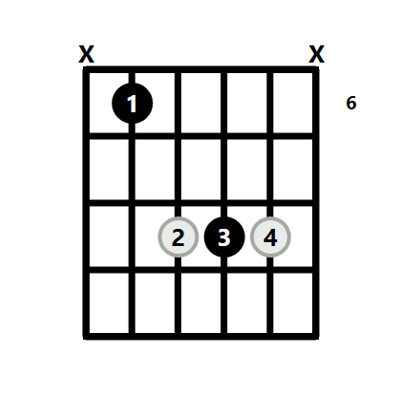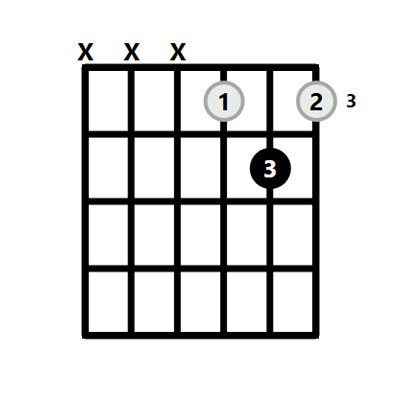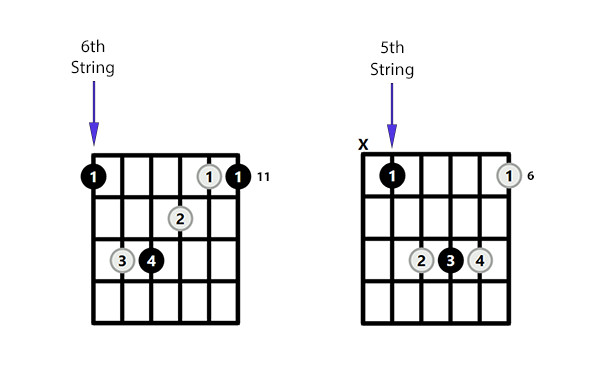The Eb Major chord, often simply called the E flat chord, is a foundational chord for guitarists across genres. From its mellow tones in jazz to its powerful presence in rock and pop, the Eb chord’s versatility makes it an essential part of any guitarist’s toolkit. This guide will delve into everything you need to know about the guitar Eb chord, providing you with various shapes, theoretical insights, and practical tips to master it.
Understanding the E Flat Major Chord
Before diving into shapes, let’s briefly explore the theory behind the Eb chord. Like all major chords, the Eb Major is a triad, meaning it’s built from three notes. These notes are:
- Eb (Root)
- G (Major Third)
- Bb (Perfect Fifth)
These notes are derived from the E flat Major scale and represent the 1st, 3rd, and 5th degrees of that scale. The intervals within the Eb Major chord, starting from the root note (Eb), are a Major 3rd and a minor 3rd, which combine to create the characteristic bright and uplifting sound of a major chord. Understanding this simple theory can deepen your connection with the chord and its role in music. The Eb Major chord is also the tonic chord, or ‘home’ chord, in the key of Eb Major, setting the tonal center for songs written in this key.
Exploring 10 Ways to Play the Eb Chord on Guitar
To truly master the Eb chord, it’s beneficial to learn multiple voicings and shapes. This not only expands your fretboard knowledge but also allows you to choose the most appropriate voicing for different musical contexts. Here are 10 shapes for the Eb Major chord, ranging from beginner-friendly to more advanced:
 Eb Major Chord – 10 Shapes
Eb Major Chord – 10 Shapes
The Standard Eb Chord Shape: The Root-5 Barre
The most common way to play the Eb guitar chord is using a root-5 barre chord shape. This shape is based on the A Major barre chord shape, moved up to the 6th fret. While often referred to as a barre chord, many guitarists play it without barring the entire fret, instead focusing on pressing down the root note and other essential notes.
 Eb Chord Guitar
Eb Chord Guitar
This shape offers a full and resonant sound, making it suitable for rhythm guitar playing in various styles.
The Easy Eb Chord Shape: Perfect for Beginners
If barre chords feel challenging, the easy Eb chord shape is an excellent starting point. This simplified version uses only the top three strings and is ideal for beginners. It shares the same shape as an open D chord, but moved up one fret.
 Easy Eb Chord Guitar
Easy Eb Chord Guitar
This shape allows you to incorporate the Eb chord into your playing early on and is perfect for situations where you need a lighter, higher-pitched Eb voicing.
Step-by-Step Guide to Playing the Standard Eb Major Chord
For those who learn best with step-by-step instructions, here’s how to play the standard Eb Major chord shape:
- First finger: Place your index finger on the 6th fret of the 5th string (A string).
- Second finger: Place your middle finger on the 8th fret of the 4th string (D string).
- Third finger: Place your ring finger on the 8th fret of the 3rd string (G string).
- Fourth finger: Place your pinky finger on the 8th fret of the 2nd string (B string).
- Strumming: Avoid strumming the 6th string (low E string) and strum down from the 5th string to the 1st string.
Following these steps meticulously can help ensure you are playing the chord correctly and develop good finger placement habits.
Eb Barre Chord Shapes: Root 6 and Root 5 Variations
As you progress, mastering barre chords is crucial. The Eb chord can be played as both a root 6 and a root 5 barre chord. The root 6 barre shape starts on the 11th fret (based on the E Major shape), while the root 5 barre shape, as mentioned earlier, starts on the 6th fret (based on the A Major shape).
 Eb Barre Chord Guitar
Eb Barre Chord Guitar
Barre chords provide a movable way to play the Eb chord and other major chords across the fretboard, offering flexibility and consistency in your playing.
Eb Major Triads: Inversions for Melodic Playing
Beyond full chord shapes, exploring Eb Major triads opens up melodic and nuanced voicing possibilities. Triads are three-note chords, and for Eb Major, the triad notes are Eb, G, and Bb. These triads can be played in three inversions:
- Root Position: Eb – G – Bb
- 1st Inversion: G – Bb – Eb
- 2nd Inversion: Bb – Eb – G
Understanding and practicing these inversions allows for smoother voice leading and more sophisticated chord voicings, particularly useful in jazz, fingerstyle, and songwriting.
 Eb Major Triad Guitar
Eb Major Triad Guitar
Musical Context: Keys Featuring the Eb Chord
Knowing where the Eb chord fits musically enhances your understanding and application. The Eb Major chord is a diatonic chord in several keys, most prominently:
- Eb Major: As the tonic chord, Eb is central to the key of Eb Major.
- Bb Major: Eb functions as the IV chord in Bb Major, a subdominant chord creating harmonic movement towards the tonic Bb.
- Ab Major: Eb is the V chord in Ab Major, a dominant chord creating tension and resolution back to Ab.
- C minor: In the relative minor key of Eb Major, C minor, Eb is the III chord, adding a major chord brightness in the minor key context.
- G minor & F minor: Eb also appears in G minor and F minor, expanding its use across minor keys.
Recognizing these key relationships allows you to anticipate and utilize the Eb chord effectively in compositions and improvisations.
Alternative and Useful Eb Chord Shapes
While the standard shapes are essential, exploring alternative Eb chord shapes can add color and variety to your playing. These shapes may not be as common but offer unique sonic textures and can be easier to transition to from certain other chords. Experimenting with different voicings can lead to new musical ideas and stylistic choices.
Eb Chord Substitutions: Expanding Your Harmonic Palette
The Eb chord can be substituted with related chords to create harmonic interest and variations. Common substitutions include:
- Eb sus4, Eb sus2, Eb add9: These suspended and added note chords provide subtle variations on the Eb Major sound, adding complexity and texture.
- Eb Major 7, Eb7, and other extensions: While Eb Major can substitute for these more complex chords in some situations (especially in simplified arrangements), it’s important to note that the reverse is not always true. Eb Major provides a foundational, simpler harmony.
Understanding substitutions broadens your harmonic vocabulary and allows for creative chord progressions and arrangements.
Scales to Play Over the Eb Chord: Soloing and Melody Creation
For soloing and melody writing over the Eb Major chord, several scales are effective:
- Eb Major Scale: The most natural choice, providing consonant and harmonically related notes.
- Eb Major Pentatonic Scale: A simpler, five-note scale that works well for blues and rock improvisation over Eb.
- Eb Lydian Mode: For a brighter, more exotic sound, the Lydian mode adds a raised 4th, creating a unique flavor.
Exploring these scales will empower you to improvise and create melodies that complement the Eb chord’s harmonic context.
Further Exploration
Mastering the Eb guitar chord is a rewarding journey that opens doors to countless musical possibilities. By understanding its theory, practicing various shapes, and exploring its musical context, you’ll add a valuable tool to your guitar playing arsenal. Keep practicing and experimenting to fully integrate the Eb chord into your musical expression.
[
